 Index
Index

Food packages generally have two types of consumer information required by the Food and Drug Administration (FDA). The Nutrition Facts section defines a serving size and describes the weights of macronutrients (fat, carbohydrate, protein) in a serving and the percentages that these macronutrients represent of the daily Recommended Dietary Allowance (RDA) for a 2000-Calorie diet. Additional information may be provided for specific minerals, vitamins, or other components of interest such as cholesterol.
The second type of consumer information is the List of Ingredients which contains the basic components of the product in order of decreasing weight. Since the basic components must be listed, products containing ingredients consisting of several components must list the components in parentheses. A breakfast cereal containing crystallized ginger must list it as "crystallized ginger (ginger root, sugar)". Manufacturers sometimes add explanatory notes about an ingredient, e.g., "BHT (a preservative)".


Food labels have a lot of technical information that is hard to interpret. We will compare the nutrition labels of raw sunflower seeds from two stores to try to figure out the differences. Weight ratios of fat, carbohydrate, and protein of 2:1:1 to 3:1:1 are very typical for nuts and oil seeds.
The most obvious discrepancy in these labels is the serving size of 28g for the Whole Foods seeds vs. 33g for the Trader Joe's seeds, both of which have 190 Calories per serving. It is unlikely that a five-gram (15%) difference in the serving size would have a negligible effect on the total calories. We also notice that the Whole Foods seeds have three times the amount of fiber as the Trader Joe's seeds, and Trader Joe's seeds have no sugars whereas the Whole Foods seeds have 1 gram of sugars. Aren't all sunflower seeds the same? How reliable are these "Nutrition Facts"?
Let us start with a simple check to see if everything adds up. The Whole Foods serving size is 28g, but if we add 17g of fat, 6g of carbohydrate, and 7g of protein the total is 30g. Oops! It is not unusual for the sum of the components to be slightly different than the whole due to rounding errors and unlisted components, but it is abnormal to have the components exceed the total serving size by 2 grams (7%).
The Trader Joe's serving size is 33g. Adding 16g of fat, 8g of carbohydrate, and 8g of protein we get 32g. This is much more consistent and the discrepancy is probably due to rounding. If we had 16.3g of fat, 8.4g of carbohydrate, and 8.3g of protein everything would add up properly, but by rounding to whole numbers we would lose 3% precision.
How about the Calories? Fat has 9 Calories per gram, and protein and carbohydrate have 4 Calories per gram. Fiber contributes no calories because it cannot be digested, so we subtract the grams of fiber from the total carbohydrate. The remaining carbohydrates consist of sugars and starches. The Whole Foods seeds have 9×17 + 4×(6-3) + 4×7 = 193 Calories. The Calories from fat are 9×17 = 153. By rounding to the nearest ten, we get 190 total Calories and 150 Calories from fat in perfect agreement with the label.
Trader Joe's seeds have 9×16 + 4×(8-1) + 4×8 = 204 Calories. The Calories from fat are 9×16 = 144. By rounding, we get 200 total Calories and 140 Calories from fat. Oops! Something is inconsistent. The total Calories calculated from the components is 5% larger than stated on the label, and the Calories from fat calculated from the components is 6% lower than on the label.
The % Daily Values are based on a U.S. government recommendation that 30% of the Calories should be from fat, 55% from carbohydrates, and 15% from protein. For a 2000-Calorie diet, this is equivalent to 67g of fat, 300g of carbohydrate that includes 25g of dietary fiber, and 75g of protein per day. The dietary fiber for the Whole Foods seeds should be 3×100/25 = 12% instead of 13%. Trader Joe's Total Fat should be 16×100/67 = 24% instead of 25%, and the dietary fiber value should be 1×100/25 = 4% instead of 5%. These differences are not significant.
From this analysis we can determine that the Whole Food nutritional label has the wrong serving size. It should probably be 30g or 31g instead of 28g, and therefore, the servings per container should be less than 16 because the weight of the container divided by the serving size should equal the number of servings. We can also conclude that Trader Joe's label has the wrong ratio of components. The most probable discrepancy is that the label has lower amounts of dietary fiber and total fat than it should have, since increasing both of them slightly would make the total Calories and the Calories from fat closer to what is stated on the label, but the protein value listed on the label may also be higher than it should be.
The raw sunflower seeds from both stores are probably identical or very similar, but the nutritional information is different through a variety of minor, but annoying errors. Who is responsible for checking these labels?

Food packages entice consumers with promises of great taste, wholesomeness, and health. Words like "all natural" , "low fat", "diet", "fat free", "nonfat", "sugar-free", and "low calorie" are prominently displayed on many food products. The Nutrition Facts and the Ingredients list which are required by law on packaged foods can be used to determine the veracity of some of these claims.

The Radura is an international symbol indicating that a food product has been treated with ionizing radiation. Since 1986, the FDA has required that irradiated foods include labeling with either the statement "treated with radiation" or "treated by irradiation", along with the Radura symbol. In the United States, irradiation labeling requirements apply only to foods sold in stores, and do not apply to restaurant foods or processed foods.
In August 2008, The FDA approved irradiation of fresh iceberg lettuce and fresh spinach to try to prevent infections by Salmonella and Escherichia coli O157:H7 (E. coli).[2] In previous years, these types of infections sickened many people in large geographic areas and the embargoes of suspected produce caused great economic losses to retailers and farmers. The FDA considers irradiation an additional tool to reduce the levels of disease-causing microorganisms, but it does not take the place of washing and proper food-handling practices. Consumers should wash fresh and bagged produce before eating unless the packaging specifically states that the product has been prewashed.
The term "organic" is used to indicate that meat, eggs and dairy products are free of antibiotics and growth hormones. Produce marked "organic" is grown with fertilizers free of synthetic or sewage components, and no genetically modified organisms are part of the product. Food has to go through a certification process to be marked "organic", but since it is impractical to check every item in every grocery store, it is not possible to guarantee that produce marked "organic" is actually organic.
Only the "100% Organic" label guarantees the U.S. Department of Agriculture's definition of organic. For products with the USDA "organic" label, only 95 percent of the ingredients must be organic. Producers can add about 200 non-organic substances to the food without sacrificing the organic claim, and the non-organic 5 percent could be sprayed with herbicides and pesticides. Products with the label "made with organic ingredients" can have as little as 70 percent organic content.

What would you expect when you buy a package of "100% Natural Granola" with oats, honey, and raisins? You would expect the product to contain only natural ingredients, right? The granola is even kosher and sanctioned by Jewish law as being especially fit for consumption (the "K" symbol and the little "D" just below "Raisins" indicates that the product is kosher and contains some dairy product). However, when we read the list of ingredients we discover a problem.

The ingredients are listed in order of decreasing weight in the product. From this, we know that the weight of the raisins is more than the weight of the vegetable oil, and that the weight of the oil is more than the weight of the almonds. Looking carefully, we notice that the "vegetable oil" consists of "partially hydrogenated cottonseed and/or soybean oil". Partially hydrogenated oil is only produced artificially at high temperatures with metal catalysts in chemical plants, which means that it is not natural at all. Hydrogenation fundamentally degrades the nutritional properties of natural vegetable oils and creates trans fats that cause cardiovascular diseases. The claim in the front of the box of "100% Natural" is clearly a misrepresentation of the contents. This labeling problem has arisen because the Food and Drug Administration has not considered what can be labeled as "natural", and the law requiring manufacturers to list the ingredients of a food product does not require the rest of the information on the package to reflect the actual contents.
In December of 2003, I submitted a petition to the FDA to try to rectify what I considered to be a labeling abuse. In December of 2005, I received a response saying that there were not enough grounds for the FDA to modify its current policy on the use of the term "natural". The letter from Margaret O'K. Glavin, Associate Commissioner for Regulatory Affairs, stated:
We discussed the issue of the use of the term "natural" in our January 6, 1993 final rule entitled "Food Labeling: Nutrient Content Claims, General Principles, Petitions, Definition of terms; Definitions of Nutrient Content Claims for the Fat, Fatty Acid, and Cholesterol Content of Food" (58 FR 2302 at 2407). In the proposed rulemaking that led to this final rule (see 56 FR 60421 at 60466, November 27, 1991), we solicited comments on whether we should define the term "natural" and, if so, how we should do so; in the proposal, we asked whether we should consider a food to be misbranded if it has undergone more than minimal processing (and what constitutes minimal processing), or if the food contains any artificial or synthetic ingredients. As we stated in the preamble to the January 6, 1993 final rule, after reviewing and considering the comments, the agency continues to believe that if the term "natural" is adequately defined, the ambiguity surrounding the use of this term that results in misleading claims could be abated. However, as the comments reflect, there are many facets of this issue that the agency will have to carefully consider if it undertakes a rulemaking to define the term "natural." Because of resource limitations and other agency priorities, FDA is not undertaking rulemaking to establish a definition for "natural" at this time. [See the complete letter in PDF format (191K)]
In other words, the FDA is not going to try to define the word "natural" anytime soon. Unfortunately, this means that consumers will continue eating synthetic ingredients like hydrogenated fats with their "100% Natural" food products.
In 2007, the food label for the product pictured above was changed. The granola was reformulated to replace the partially hydrogenated oil with canola oil. The requirement by the Food and Drug Administration to disclose the amount of trans fat per serving in 2006 has motivated many manufacturers to replace hydrogenated fats with other fats that have no trans fatty acids. Unfortunately, the meaning of the term "natural" continues to be a source of confusion and litigation.
Statements like "Nothing Artificial" or "No Artificial Ingredients" could mean that the product contains all natural ingredients, but these statements are also abused by manufacturers in the same way as the "100% Natural" claims.

The yogurt label above says "All Natural" and "No Artificial Anything". If you look carefully, you will see that "No Artificial Anything" is actually a trademark registered in the U.S. Patent Office, and contains the registered trademark symbol "®". A trademark can be placed on any product and its purpose is to provide brand distinction and enhance commerce. A trademark is not a nutritional claim, even though it may look like one.

The list of ingredients for this yogurt contains "high fructose corn syrup" which does not exist in nature, but is derived chemically from corn starch. The label also lists "modified corn starch" which is starch that has been modified chemically to stabilize its gelling characteristics. Once it has been modified, this starch is not a natural ingredient either. Consumers basically have to ignore the front of the package and read the list of ingredients, although sometimes the list is in very small letters and printed in hard-to-read, low-contrast backgrounds.
Impressive Trademark Games
Activia yogurt is supposed to help regulate the digestive system and facilitate bowel movements with its "Bifidus Regularis" bacteria. However, "Bifidus Regularis" is actually a trade name made up by Dannon for a strain of Bifidobacterium animalis. Probiotic bacteria are essential for good health, but the strategy of using a trade mark gives Dannon a marketing advantage because other brands of yogurt cannot use "Bifidus Regularis" in their advertisements. Dannon uses the trade name "Bifidus Digestivum" in the UK, and "Bifidobacterium Lactis" in Canada. The scientific-sounding names are confusing for consumers, but they are a good marketing strategy, although the product may not offer significant benefits over other yogurts.
Supplemental International Terminology: etiqueta de alimentos, étiquette alimentaire, etichetta alimentare, rótulo de alimentos, Lebensmittel-Label, voedsel label, fødevarer etiket, potraviny štítek, mat etikett, elintarvikkeiden pakkausmerkinnöissä.